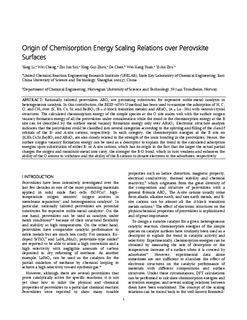Origin of Chemisorption Energy Scaling Relations over Perovskite Surfaces
| dc.contributor.author | Li, Yang | |
| dc.contributor.author | Cheng, W | |
| dc.contributor.author | Sui, Zhi jun | |
| dc.contributor.author | Zhou, Xinggui | |
| dc.contributor.author | Chen, De | |
| dc.contributor.author | Yuan, Wei-kang | |
| dc.contributor.author | Zhu, Yi-an | |
| dc.date.accessioned | 2020-02-05T12:26:33Z | |
| dc.date.available | 2020-02-05T12:26:33Z | |
| dc.date.created | 2020-01-20T14:48:12Z | |
| dc.date.issued | 2019 | |
| dc.identifier.citation | Journal of Physical Chemistry C. 2019, 123 28275-?. | nb_NO |
| dc.identifier.issn | 1932-7447 | |
| dc.identifier.uri | http://hdl.handle.net/11250/2639820 | |
| dc.description.abstract | Rationally tailored perovskites ABO3 are promising substitutes for expensive noble-metal catalysts in heterogeneous catalysis. In this contribution, the BEEF-vdW + U method has been used to examine the adsorption of H, C, O, and CH3 over (K,Rb,Cs,Sr,Ba)BO3 (B = d-block transition metals) and ARuO3 (A = La to Ho) with various crystal structures. The calculated chemisorption energy of the simple species at the O site scales well with the surface oxygen vacancy formation energy of all the perovskites under consideration, while the trend in the chemisorption energy at the B site can be described by the surface metal vacancy formation energy only over ARuO3. Electronic structure analysis indicates that the perovskites could be classified into several categories according to the splitting and filling of the d and f orbitals of the B- and A-site cations, respectively. In each category, the chemisorption energies at the B site on (K,Rb,Cs,Sr,Ba)BO3 and ARuO3 are also closely related to the strength of the ionic bonding in the perovskites. Hence, the surface oxygen vacancy formation energy can be used as a descriptor to explain the trend in the calculated adsorption energies upon substitution of either B- or A-site cations, which has its origin in the fact that the larger the actual partial charges the oxygen and transition-metal ions carry, the stronger the B–O bond, which in turn weakens and enhances the ability of the O anions to withdraw and the ability of the B cations to donate electrons to the adsorbates, respectively. | nb_NO |
| dc.language.iso | eng | nb_NO |
| dc.publisher | American Chemical Society | nb_NO |
| dc.title | Origin of Chemisorption Energy Scaling Relations over Perovskite Surfaces | nb_NO |
| dc.type | Journal article | nb_NO |
| dc.type | Peer reviewed | nb_NO |
| dc.description.version | acceptedVersion | nb_NO |
| dc.source.pagenumber | 28275-? | nb_NO |
| dc.source.volume | 123 | nb_NO |
| dc.source.journal | Journal of Physical Chemistry C | nb_NO |
| dc.identifier.doi | https://doi.org/10.1021/acs.jpcc.9b08741 | |
| dc.identifier.cristin | 1778053 | |
| dc.relation.project | Notur/NorStore: NN4685K | nb_NO |
| dc.description.localcode | Locked until 29.10.2020 due to copyright restrictions. This document is the Accepted Manuscript version of a Published Work that appeared in final form in [Journal of Physical Chemistry C], copyright © American Chemical Society after peer review and technical editing by the publisher. To access the final edited and published work see https://doi.org/10.1021/acs.jpcc.9b08741 | nb_NO |
| cristin.unitcode | 194,66,30,0 | |
| cristin.unitname | Institutt for kjemisk prosessteknologi | |
| cristin.ispublished | true | |
| cristin.fulltext | postprint | |
| cristin.qualitycode | 1 |
